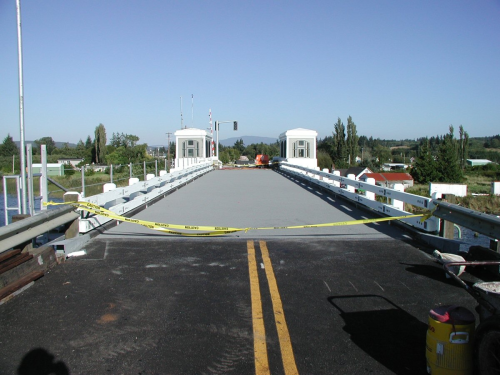
The applications where FRP decks are great matches are:
- movable bridges;
- historic steel truss bridges;
- bridges with steel grating; and
- pedestrian deck additions to vehicle bridges.
Easy to move
Movable bridges are found mostly in coastal and port areas. These bridge types include lift, swing and bascule bridges. Traditionally, the decks for these bridges are steel grate or steel/concrete. Deck weight has a direct effect on the cost of the mechanical equipment and the operational costs. FRP decking is the lowest weight option. It provides a solid decking surface to protect the superstructure and is preferable to steel grating.
FRP decking has been used on a number of movable bridges. In a few cases, these bridges are in port areas and carry a significant percentage of heavy truck traffic. Since weight is a driving factor, a polymer concrete wear surface is typically used rather than thicker and heavier asphalt.
Saving history
Light weight decking is also valuable in the case of the historic steel truss bridge. Many steel truss bridges were constructed in the first half of the 1900s and carry historic value for their community. Many of these bridges are load rated since they were not designed for current vehicles. FRP is a great option for reducing dead load. This reduction can be as much as 80 lb/ft2. Rather than replacing the historic bridge, FRP decking enables the community to keep the bridge and still handle higher loaded vehicles.
Covering the superstructure
FRP decking provides an effective replacement option for cases involving bridges with steel grating. While steel grating offers a light weight of 17-28 lb/ft2, exposure to water and chemicals quickly takes its toll on the grating and exposed superstructure underneath. The serrated grating surface becomes worn over time and vehicles lose traction during rain, snow or ice. In many cases, the superstructure was designed for the weight of the steel grate deck. Bridge owners must either opt for a new steel grate or an FRP deck. Since filling the steel grate with concrete can add up to 55 lb/ft2 to the weight, this option is not viable. FRP offers a weight of just 16-20 lb/ft2 making this option preferable. A second benefit of the FRP deck is that businesses, hotels, restaurants and parks located near the structure enjoy a reduction in noise with the quieter FRP deck. A lightweight, solid surface deck is the right answer to reduce corrosion of the superstructure.
Share the road (and the bridge)
The fourth case application is attaching pedestrian/bicycle bridges to existing vehicle bridges. With more communities requesting bicycle paths and pedestrian connectivity, an attractive alternative to building completely new bridges is to cantilever the pedestrian bridge off the vehicle bridge structure. Minimising dead load is essential to the success of such a project. If structurally feasible, adding to the vehicle bridge is more cost effective than constructing a new pedestrian bridge parallel to the vehicle bridge.
This article is an extract from the feature FRP bridge decking – 14 years and counting, which was published in the January/February 2010 issue of Reinforced Plastics magazine. Read the complete feature here.





